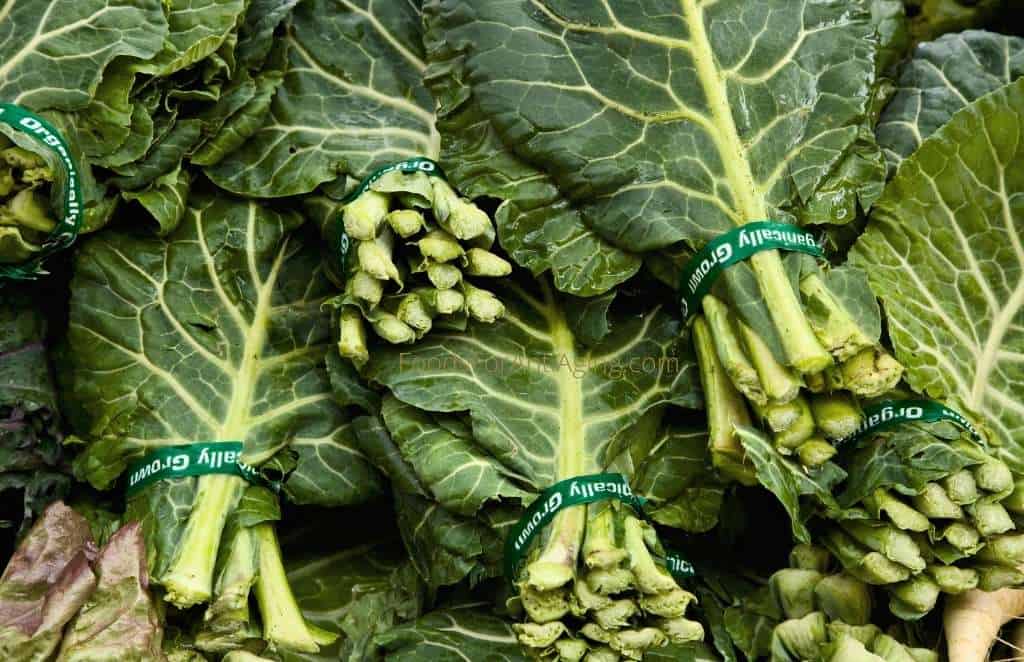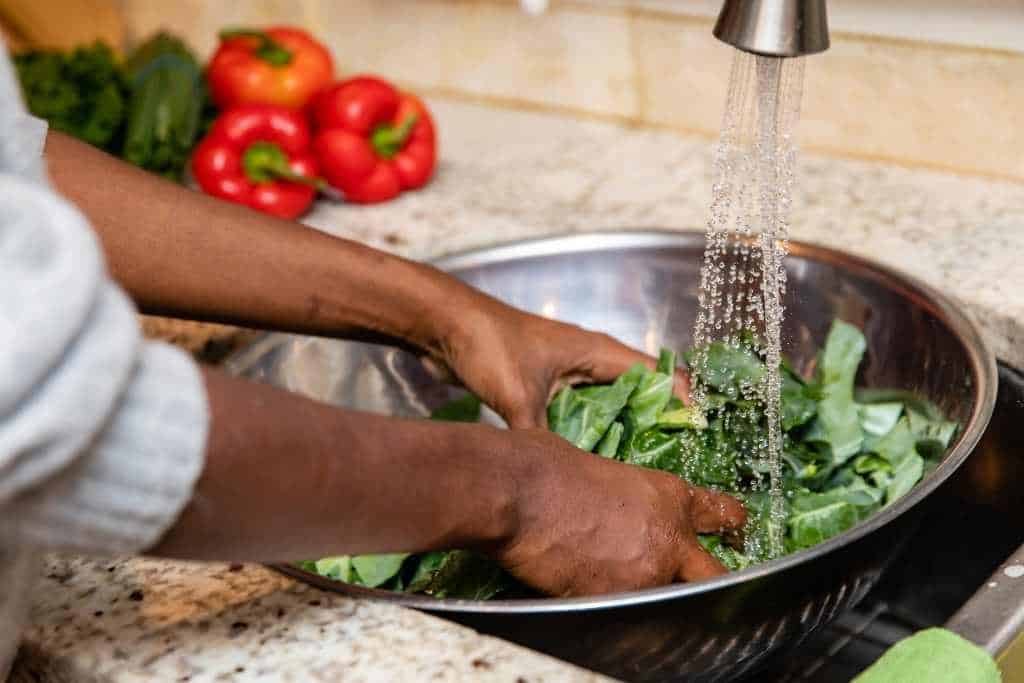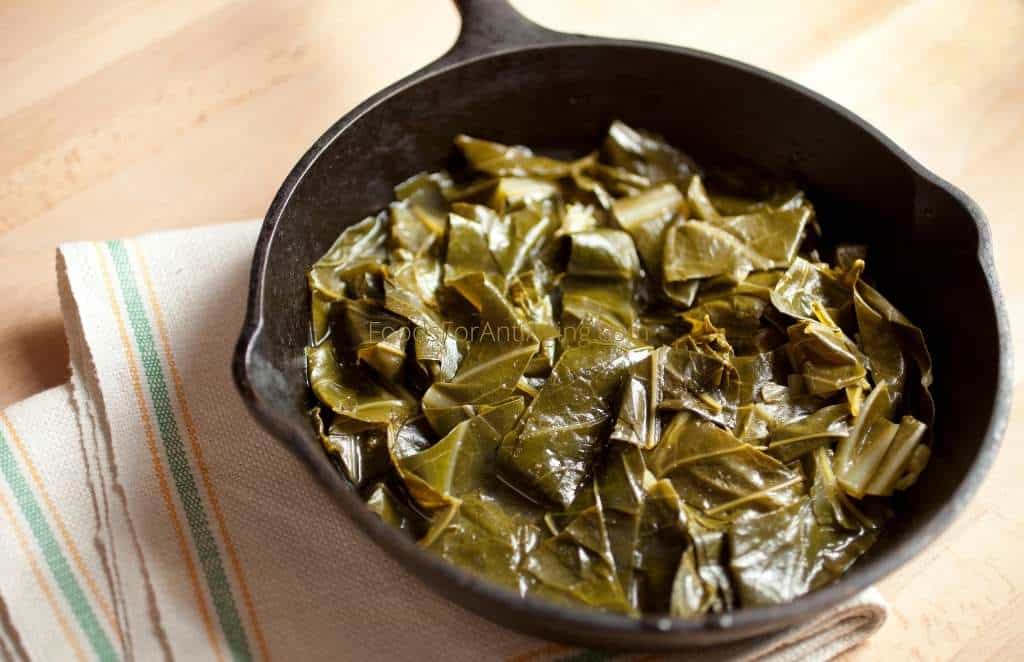This Is How To Store Your Collard Greens
Let’s examine the best way to store collard greens.
The best way to store collard greens short-term is in the refrigerator. Place unwashed collard greens into plastic bags removing the excess air and seal. Store the sealed bag in the crisper drawer of the refrigerator for 5-7 days. For long-term, blanch them and store in the freezer up to 12 months.
This article will list each storage method and provide them to you in easy step-by-step directions. The methods examined are for raw or cooked greens including the refrigerator or freezer. For short or long-term, this article covers it all.
How To Store Collard Greens

As a Certified Health Coach many clients ask me about food storage including collard greens. I purchase and consume them every week. Therefore, I have researched this topic in the past and present. Let’s examine the storage methods closely.
Storing collard greens depends on when you’re going to use them or if they’re raw or cooked.
The following are 6 ways to store collard greens:
- Refrigerate fresh collard greens in resealable bags.
- Refrigerate fresh collard greens wrapped in damp paper towels.
- Refrigerate cooked collard greens.
- Freeze fresh collard greens by blanching.
- Freeze fresh collard greens without blanching.
- Freeze cooked collard greens.
Each of the six storage methods is described in detail below.
1. Refrigerate Fresh Collard Greens In Resealable Bags
If you bring home fresh collard greens from the supermarket or farmer’s market, how to store them depends on when you plan on using them. If you’re using them within the next week, this method is best.
The best way to refrigerate fresh collard greens:
- Place unwashed collard greens into a resealable plastic food bag.
- Remove as much excess air as possible and seal the bag.
- Place the sealed bag into the crisper draw of the refrigerator.
- Store up to 5-7 days.
If you don’t have a resealable plastic bag, some specific instructions should be followed. This brings us to the next section of the article directly below.
Collard greens should only be left out of the refrigerator no more than two hours.
Disclaimer: Some links in this article are affiliate links which means I may earn a small commission at no extra cost to you. As an Amazon associate I earn from qualifying purchases.
Why Store Collard Greens Unwashed?

Washing collard greens or other leafy vegetables adds moisture, which speeds up decay and causes them to spoil faster. Decayed food is essentially a waste of time and money, not to mention it can contaminate other foods in the refrigerator1.
Therefore, save the washing of your greens for when you want to use them.
However, if you bought them from the farmer’s market or harvested them from your garden, they may be dirty. If this is the case, you may want to wipe them off with a moist towel and dry them well with a paper towel or butcher paper.
Properly removing moisture isn’t as easy as it sounds because of the delicate nooks and crannies. If you mistakenly rinsed the greens and they’re wet, I recommend employing the best tool for the job – salad spinners.
Salad spinners use centrifugal force to spin your greens in a strainer basket and collect the excess water in an outer bowl. These devices work so efficiently they dry the leafy greens without any bruising.
If you don’t have a salad spinner, they don’t cost much money. Check out these affordable ones on Amazon, salad spinners.
2. Refrigerate Fresh Collard Greens Wrapped In Damp Towels
If you ran out of resealable plastic bags, the collard greens can’t be exposed to the air for long. Therefore, let’s examine how to refrigerate them in damp paper towels.
- Place unwashed collard greens onto a damp paper towel.
- Gently roll or wrap the paper towels around them.
- Place them into a plastic bag.
- Place the plastic bag into the crisper draw of the refrigerator.
- Store in the refrigerator for 5-7 days.
- Check the paper towels every day and replace with fresh damp towels if necessary.
3. Refrigerate Cooked Collard Greens

Let’s say you’ve already cooked the collard greens and will be eating them in the next few days. You may be wondering how to refrigerate them.
- Allow the cooked collard greens to completely cool.
- Within two hours place the cooled collard greens into a sealable airtight container or plastic bag.
- Remove as much excess air as possible and seal.
- Store in the refrigerator up to three days.
If you plan on storing them longer, check the section further down on how to freeze them cooked.
4. Freeze Fresh Collard Greens By Blanching
This first method is to freeze fresh collard greens using the blanching method2.
The best way to freeze fresh collard greens:
- Trim the collard greens to your desired size or leave them whole.
- Rinse the greens under cold running water.
- Bring a large pot of water to a boil.
- While waiting for the water to boil, fill a large bowl with water and ice cubes.
- Add the collard greens to the boiling water.
- Boil them for 3 minutes.
- Immediately remove them from the boiling water and place them into the ice water for 2 minutes.
- Drain and place them onto a paper towel and pat them dry.
- Place the dried collard greens onto a parchment covered baking sheet. Ensure they’re not touching each other.
- Place the baking sheet into the freezer until they are fully frozen.
- Remove the baking sheet and transfer the frozen pieces into plastic freezer bags.
- Remove as much excess air as possible and seal the freezer bag.
- Date the bag and store in the freezer up to twelve months.
By spacing them apart on the baking sheet prevents them from sticking together when frozen. This allows you to remove the leaves individually from the freezer bag instead of having them frozen in one large chunk3.
Sealing
Removing as much air as possible from the freezer bag is important and helps prevent freezer burn4.
The best way to remove excess air from the plastic freezer bag is to use a vacuum sealer. They are one of those items making you wonder how you did without one before purchasing it.
I use the FoodSaver sealer. Amazon has them and other affordable ones, vacuum sealers.
Without a sealer, close the top of the bag leaving a small opening to fit a straw through. Suck the excess air out of the plastic bag and quickly close the top after removing the straw.
Collard greens can be frozen without blanching although blanching increases the freshness and longevity of the greens in the freezer.
Blanching
Blanching is the process of quickly submerging vegetables in hot water, then chilling them in ice water before freezing. The rapid cooking followed by immediate cooling slows or ceases a specific enzyme activity in the vegetables, making them better suited for the freezer.
If you would like to skip the blanching step5, keep reading the next section to find out how6.
5. Freeze Fresh Collard Greens Without Blanching
As mentioned earlier, some people would rather freeze collard greens without blanching.
The best way to freeze collard greens without blanching:
- Trim the collard greens to the desired size or leave them whole.
- Clean the greens by wiping them with a moist towel.
- Place them onto a paper towel and allow them to dry.
- Place the dried pieces onto a parchment covered baking sheet. Ensure they’re not touching each other.
- Place the baking sheet into the freezer until they are fully frozen.
- Remove the baking sheet and transfer the frozen pieces into plastic freezer bags.
- Remove as much excess air as possible and seal the freezer bag.
- Date the bag and store in the freezer up to twelve months.
Freezing Individual Servings
Some people like to store individual servings into separate bags. Place a serving amount of collard greens in a bag and remove as much air as possible to preserve them better and prevent freezer burn7.
If possible, use a smaller package for freezing improving the quality and longevity of storage. Keep the plastic bags as level as possible while they’re freezing. After they’re frozen, they can be moved around and reoriented to fit conveniently in the freezer.
This method allows you to take however many you need without worrying about letting air into the bag. The package-freeze method allows you to portion out your serving sizes ahead of time, so you aren’t defrosting too many leaves that end up going to waste8.
6. Freeze Cooked Collard Greens
There are times too much collard greens was cooked and you don’t want to throw them away or eat them in the next few days. In addition, some people want to cook them first before freezing them.
Cooked collard greens can be frozen. They don’t require blanching due to the previous cooking process already slowed the enzyme action. Cooked collard greens can be stored in plastic freezer bags and frozen up to twelve months.
The best way to freeze cooked collard greens:
- Allow the collard greens to completely cool.
- Place them into plastic freezer bags or an airtight container.
- Remove as much excess air as possible.
- Date the bag and place it into the freezer up to 12 months.
Ensure they are completely cool. Placing them into the bag while warm or hot can cause steam to escape into the bag. This will expose them to a freezer burn or spoilage quicker.
If there are sauces or other items involved, you may want to store them separately. If the ingredients can’t be separated, research the storage recommendations for the other items.
Defrosting Frozen Collard Greens
The best way to defrost frozen collard greens is to transfer them from the freezer to the refrigerator until they are defrosted. The amount of time will vary depending if the greens were frozen separated or bunched together.
Although they shouldn’t take too long, if you don’t have enough time, they can be placed onto the counter to defrost.
Collard greens can be cooked frozen if the greens were frozen separated. The collard greens can be added directly to the dish being cooked.
This method works particularly well when adding the frozen collard greens to soups, stews or a stir-fry.
How To Tell If Collard Greens Are Bad
Ways to tell if fresh collard greens are bad:
- The collard greens are soft or wilted.
- They are slimy or feel moist.
- They have turned color, usually from green to yellow.
- They have an unusual or bitter odor.
It’s a good practice to learn what each of the food you typically eat smells like. This way when they turn bad and have a different odor, it’s easier to identify. Collard greens have a natural sulfuric smell when fresh.
How To Keep Collard Greens From Wilting
Like most leafy greens, collards are vulnerable to wilting after harvest, which happens when they lose moisture. During this process, their vitamin content reduces and may be unsafe for eating afterward.
The best way to avoid wilting is to prevent it from happening in the first place.
To keep collard greens from wilting, pack them in airtight plastic bags and put them in the crisper drawer of your refrigerator. Another way is to cover them in a damp paper towel and place them in an unsealed plastic bag before refrigerating them. Avoid overloading the crisper drawer when storing them.
Storing them this way helps to keep them cold and moist between 32℉ to 36℉ which is recommended for cool-season crops9.
Consequently, this temperature and relative humidity prevent wilting and softening of the leaves and helps them maintain their appearance, salable weight and nutritional quality and flavor10.
If you have any questions to ask me about this article don’t hesitate to comment below or email us. You can find an email on our contact page.
Read Next – More Food Storage Articles!
The Proper Way To Freeze Bok Choy
Your Guide To Freezing Brussels Sprouts
A Guide To Preserve Fresh Cherries – The 5 Best Ways
A Guide To Storing Toasted Bread
- Texas Cooperative Extension: Safe Handling of Fresh Fruits and Vegetables [↩]
- National Center for Home Food Preservation: Freezing Greens [↩]
- National Center for Home Food Preservation: Preserving Food: Freezing Vegetables [↩]
- FDA: Food Safety A to Z Reference Guide [↩]
- National Center for Home Food Preservation: Freezing Blanching [↩]
- Clemson Cooperative Extension: Why Blanch [↩]
- Glad: How to Store Collard Greens [↩]
- University Of Minnesota Extension: Freezing leafy greens for later use [↩]
- The University Of Maine: Storage Conditions Fruits and Vegetables [↩]
- Michigan State University: Using, Storing, and Preserving Greens [↩]
